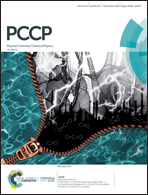Graphene-covered transition metal halide molecules as efficient and durable electrocatalysts for oxygen reduction and evolution reactions†
Abstract
Proton exchange fuel cells (PEFCs) are one of the most popular and promising energy conversion devices because of their highly stable and efficient membranes in acidic media, but there is a lack of durable non-noble metal electrocatalysts suitable for acidic environments. Herein, we designed a new type of electrocatalysts consisting of transition metal halide molecules covered by graphene sheets, which is supported by experiments. To rapidly screen the best catalysts from numerous candidate materials, the electronic structures, reaction free energies and overpotentials of those graphene-covered halide catalysts were studied by the first-principles calculations to predict the catalytic activities for oxygen reduction reaction (ORR) and oxygen evolution reaction (OER). An intrinsic descriptor, the electrostatic force induced by the metallic ions, was found to well describe the catalytic activities and provide a better understanding of the local electrical field effects on catalytic activities. The spin-down d-band center was also introduced to describe catalytic activities of the catalysts. The results demonstrate that the graphene-covered CrBr2 shows the best bifunctional catalytic activities for fuel cells while graphene-covered CoF2 could well facilitate H2O2 production. These catalysts are better than the best commercial noble metal catalysts (e.g., Pt and RuO2) in terms of overpotentials and activities. This work provides a theoretical base for rationally designing durable electrocatalysts with excellent catalytic activities.



 Please wait while we load your content...
Please wait while we load your content...